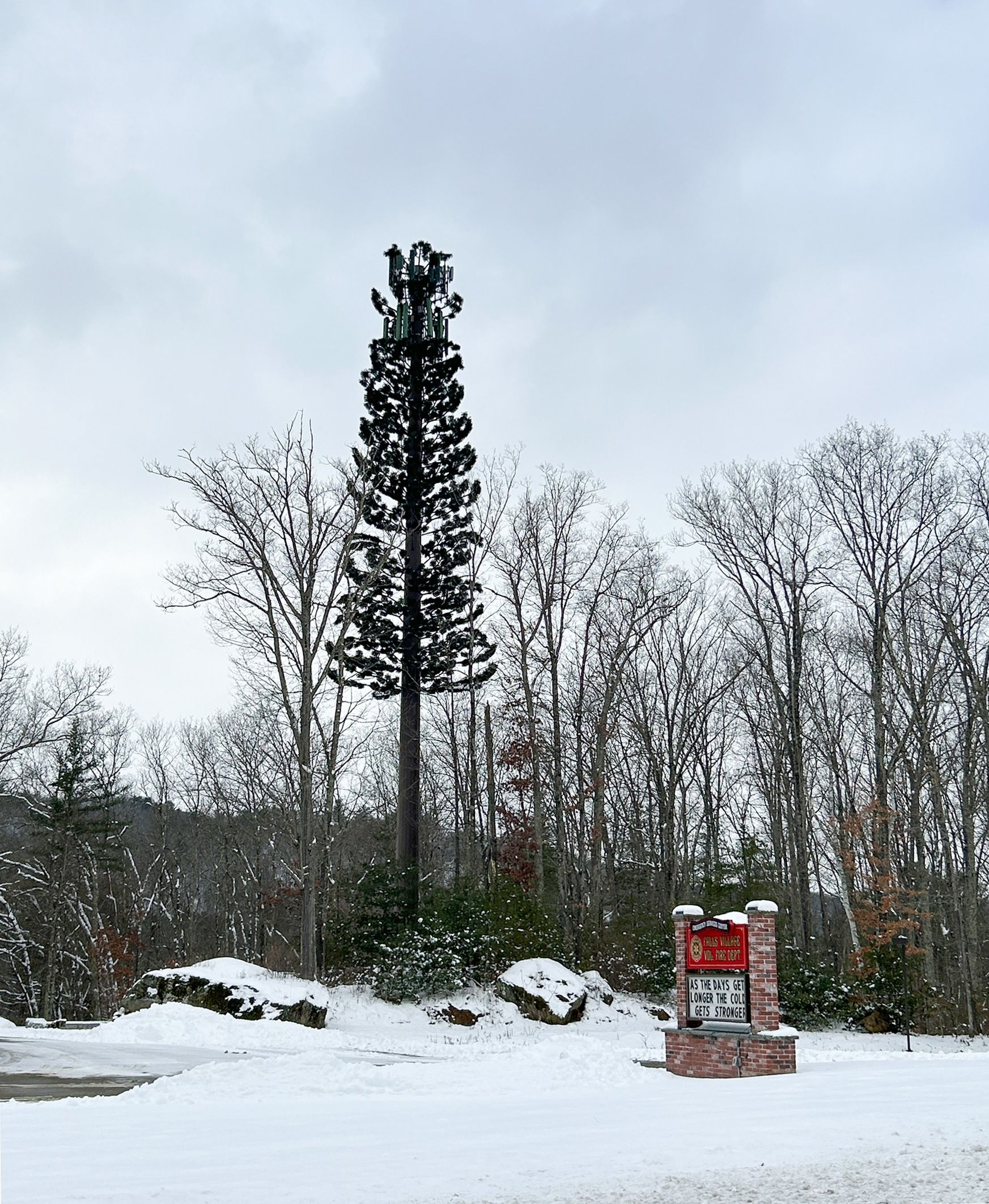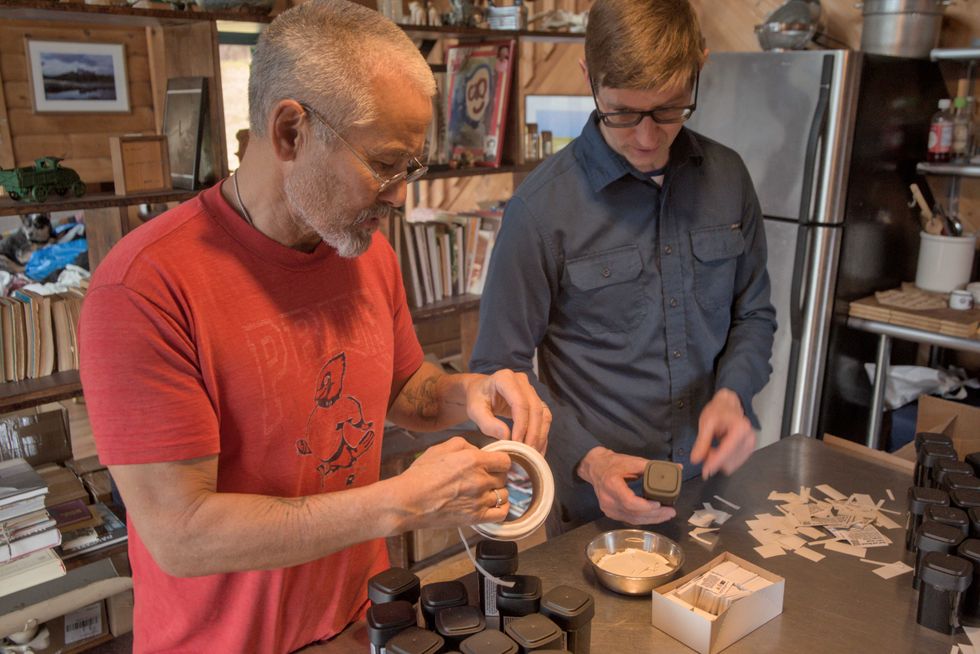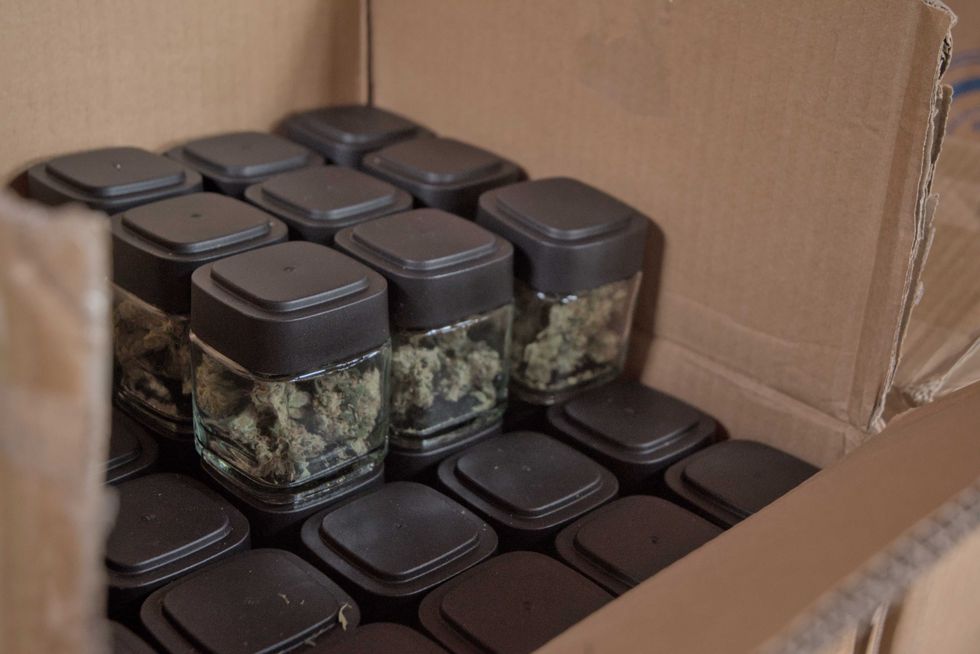Can you hear me now?

This cell tower by the Falls Village Fire Department on the side of Route 7 is disguised like a tree to better fit in among the rural, forested landscape of the Connecticut's Litchfield hills.
Photo by Caitlin Hanlon

This cell tower by the Falls Village Fire Department on the side of Route 7 is disguised like a tree to better fit in among the rural, forested landscape of the Connecticut's Litchfield hills.
Drivers and residents across Northeast Dutchess County, New York, and Connecticut’s Northwest Corner are well aware of the area’s spotty cell phone coverage.
“Cell phones suck,” Amenia Volunteer Fire Chief Chris Howard said. He echoed the feelings of many residents and visitors to the area who contend with dropped calls and failed text messages on a regular basis.
Spotty cell service is annoying for drivers relying on GPS for directions and it creates problems for Howard and his department. Howard said the truck’s computer-assisted routing uses the T-Mobile network. When trucks have to travel north of the traffic light in the middle of downtown Amenia, their cell service drops out and crews could lose those directions. Usually, Howard said, this isn’t a huge setback for his crew, but that’s not the only challenge emergency responders face because of spotty, slow service.
Hikers hitting the hills often travel through dead zones. The region’s rugged terrain — while scenic and inviting to hikers — hurts coverage. Hills block signals from distant towers, so if hikers have an accident in a remote area they may have trouble getting in touch with emergency services. Howard said Amenia’s rope crew will ask for coordinates, but sometimes the hiker can’t provide good information. “Then they’re hiking blind,” Howard said.
Cell phone tower construction is slow in rural areas across the United States, but several key factors contribute to subpar service in Northeast Dutchess County and the Litchfield Hills. Chief among them are the challenges presented by rugged, undeveloped land. Regions with lots of hills, few people and less power and telecommunications infrastructure are more difficult and costly to service than suburban or urban areas, according to a 2019 New York Upstate Cellular Coverage Task Force report.
John Emra, AT&T’s Atlantic region president, said cell towers require power and fiber optic connections, and many rural sites don’t already have that infrastructure. Another consideration is access. Towers can’t be too remote, otherwise emergency repairs are too difficult. However, they can’t be too close to large groups of people. Often, service roads have to be built to sites on remote ridgelines and hilltops. All this drives up the cost of cell tower construction, and the 2019 cell coverage task force report says the higher cost disincentivizes rural investment.
That report also cites local zoning codes as a potential hurdle for construction, but Emra said regulations don’t completely halt progress. In his 24 years with AT&T, he said rural communities have become increasingly open to cell tower construction and upgrades. Building codes in Northeast Dutchess County and the Litchfield Hills still present unique challenges for cell towers. Special attention is paid to ridgelines and scenic views in the area, so tall towers on high hills are discouraged through local laws. However, cell towers constructed in valleys or on the sides of ridges are less effective, covering much smaller areas because of the hills blocking the signal.
“Even 10 years ago if you proposed a new site — particularly in Litchfield County, Connecticut — you would likely meet some fairly fierce community resistance,” Emra said. “I’ve seen the change where we now have communities asking us to build.” He said AT&T recently finished a project at a site near Stanfordville, New York, and there’s a site near Salisbury, Connecticut, which should be online by the end of the year. Additionally, AT&T has built cell antennas across Dutchess County called “small cell nodes,” which are installed on utility poles but provide coverage over shorter distances than a full-size tower.
Representatives from Verizon did not respond to requests for comment.
The former home of Demitasse at 32 Main St. in downtown Millerton will become the home of Wassaic-based cannabis farmer Douglas Broughton’s new dispensary.
MILLERTON — Wassaic-based cannabis grower Douglas Broughton plans to open a dispensary this spring in the former Demitasse storefront on Main Street.
Broughton signed a lease for the 32 Main St. storefront on Dec. 1 and plans to reopen the space as the Black Rabbit Farms cannabis dispensary following modest renovations. The work, he said, will include cosmetic updates and the installation of freestanding, custom-made display cabinets.
“We hope to be open in March,” Broughton said.

Broughton has been growing cannabis since 1995 and has worked in the legal medical and recreational cannabis industries since their inception, when states across the U.S. began easing prohibitions on the drug..He said quality is paramount to him, and he plans to maintain that commitment in his new dispensary.
“There’s going to be probably 10 to 20 different products for sale at any one time,” Broughton said, emphasizing a desire to exclusively stock locally-produced cannabis from micro-growers. “I’m trying to get the small farm, the micro — which is the small license people — up and running and trying to help them out how to grow so I can feature their cannabis.”
Broughton has not assembled a complete list of participating growers yet, but his own Black Rabbit Farms cannabis will be among the dispensary’s selection. He grows cannabis in a greenhouse at his Wassaic home, using artificial light and a hands-on approach.
That hands-on approach results in lower yields, but Broughton said he values quality over quantity. His wife, Maria Laura Quintero, said he has even sacrificed entire harvests when problems arose.

“He has wiped out entire crops because he saw a mite,” Quintero said. “He won’t give that to the public. He would prefer to kill the whole thing and start all over.”
By choosing an existing retail space in the Village of Millerton, Broughton was not required to go through lengthy approval processes before municipal boards.
The location is ideal, he said, though he acknowledged parking is limited and plans to warn customers on the dispensary’s website. “Parking, unfortunately, is going to be about a block walk either way,” Broughton said. “You’re going to have to park at the rail trail and walk up, or go park above the church and walk down. It’s a nice walk — three minutes, you’re there.”
For customers who prefer not to walk, Black Rabbit Farm will offer delivery within an Office of Cannabis Management-approved radius of the storefront. “It’ll be probably, I don’t know, 10 miles as the crow flies,” Broughton said.
Broughton said he wants the dispensary to fit in with downtown Millerton. “The motif is going to blend right in,” he said. “It’s not going to be this big neon pot leaf — like a McDonald’s thing.”

The former Presbyterian church on Main Street in Millerton, which Millerton resident Alex That has proposed converting into a private education center
MILLERTON — Millerton resident Alex That presented plans for the former Presbyterian church on Main Street to the Millerton Planning Board at a rescheduled meeting Tuesday, Dec. 16.
That is proposing to convert the church into a private education center offering classes in music, video production and DJing for people of all abilities.
The Millerton site would be the second location for Caffeine Academy, which opened its first location in West Babylon, N.Y., in 2013.
The meeting was marked by confusion over the village’s application approval process, with That and his architect repeatedly asking board members to clarify what steps were required and in what order they would occur.
During public comment, Zoning Board of Appeals Chair Kelly Kilmer explained there are two potential paths forward for the application.
One option would require That to apply to the Zoning Board of Appeals for a parking variance, a process that would involve a full environmental review and public hearings separate from those required by the Planning Board.
The second option would be to wait for a recently passed local law to take effect. The law exempts buildings in the village’s General Business District from additional parking requirements, which would eliminate the need for a parking variance.
“The Village of Millerton Board passed a local law amending the village code for the General Business District and parking variances, which, in all honesty, Alex, works in your favor,” Kilmer said.
Kilmer said Local Law C must be stamped and filed by the New York Secretary of State before it officially goes into effect. The process typically takes between 30 and 60 days and could be further delayed by the holiday season.
Until that approval is finalized, the Caffeine Academy proposal would require parking variances from the Zoning Board of Appeals.
“If you want to move forward, you would fill out an application,” Kilmer said. “I’ll make sure that we get a meeting together.”
Planning Board members recommended that the application move to the Zoning Board of Appeals for a parking variance. However, it remained unclear at the end of the meeting whether That would proceed with that option or wait until Local Law C is officially on the books.
The former agricultural weigh station at 7723 S. Main St. in Pine Plains, where the Planning Board approved plans for the proposed Upstate Pines cannabis dispensary.
PINE PLAINS — Planning Board members granted final approval Wednesday, Dec. 17, for two major commercial projects: the proposed Upstate Pines cannabis dispensary and a large lumber mill and showroom.
The site plan for the dispensary was approved by a 6–0 vote.
The proposed cannabis dispensary will be the second location of Red Hook-based dispensary business Upstate Pines, founded by Brian Seiler, Ben Abrahams and Ben Abrahams in 2024. Planning board members approved site plans that propose to utilize the former historic weigh station building at 7723 S. Main St. across from the Pine Plains Post Office.
The proposal, designed by architect Kristina Dousharm, underwent a lengthy approval process that included public comment earlier in the fall. Residents urged the board to be mindful of the building’s historic character — as the community’s former agricultural weighing station — and raised concerns about its proximity to the Pine Plains Firehouse on an adjacent parcel and the Post Office.
Although Pine Plains’ local law prohibits dispensaries within 300 feet of the firehouse or the Post Office, state law supersedes those restrictions. Planning Board members ruled in October that the local provisions are unenforceable, eliminating the need for a waiver.
Board members also approved the site plan and granted necessary waivers to The Hudson Co., which plans to build a 50,000-square-foot lumber mill, office building and showroom just south of Stewart's Shops gas station on Route 82 at the southern entrance to downtown Pine Plains.
Approval was unanimous with a 7-0 vote and no abstentions.
The lumber mill will produce wood beams, flooring and paneling.
Hudson Co. representatives proposed the large mill and expanded campus because the operation had outgrown a manufacturing facility it currently occupies at 2290 Route 199 in Pine Plains. LaBella Associates engineers designed the expanded campus.
The Upstate Pines cannabis dispensary first went before the board in August, and the Hudson Co. mill and showroom has been under review since May.
Ralph Fedele sits at a desk in the historic Irondale Schoolhouse, which he led the effort to relocate to downtown Millerton.
MILLERTON — After serving for 12 years on the North East Town Board, Ralph Fedele says he has only one regret.
“I wish I could be called a ‘local,’” he joked with a warm, booming laugh.
Fedele moved to Millerton from New York City 37 years ago, in 1988, and has since worn many hats — volunteer, historian, advocate, elected official — yet he still doesn’t believe he’s earned that title.
“I’m a transplant,” he said matter of factly. “I’m from the city.”
Before settling in Millerton, Fedele spent 25 years working in merchandising at JCPenney.
His roots, however, trace back to Rhinebeck, where he grew up on a 97-acre farm and enjoyed what he describes as an idyllic childhood.
“It was marvelous,” he said, with a twinkle of nostalgia in his eyes. As a boy, he climbed apple trees, spent hours in the family barn’s hayloft, played with neighbors until sunset, and helped his Sicilian grandmother — his nonna — in the garden. Today, Fedele wears her ring. “Any time I’m a little depressed or I want to remember,” he said, “I can talk to her.”
Growing up with an Italian grandmother sparked a lifelong love of history and culture. That curiosity eventually took Fedele to Italy, where he visited the church in which his grandmother was baptized. “Because I love history so much, I wanted to know where my grandmother was from, so I traveled to her village in Sicily.”
Along the way, he uncovered another piece of family history. His great-grandfather, Giovanni Nicolini, was a noted Italian sculptor whose work still stands outside Palermo’s Teatro Massimo, the largest opera house in Italy. Fedele later made a pilgrimage there and photographed his ancestor’s name on the bronze plaque outside of the theater.

The Irondale Schoolhouse
Years after settling in Millerton full time, Fedele was driving north on Route 22 when he spotted an old, classic building and couldn’t stop thinking about it.
“It was in dire straits,” he recalled. “Right on the road, but beautiful. I remember thinking, ‘Wouldn’t that be a great building to move into the village?’”
That moment would eventually turn into Fedele’s lasting legacy.
He left his post at the North East Historical Society to found Friends of the Irondale Schoolhouse, leading an eight-year effort to “move, restore, and repurpose the building.”
Supervisor Chris Kennan said the project remains inseparable from Fedele’s name. “Every time I pass by the Schoolhouse, I think of Ralph,” Kennan said. “It was his vision and persistence that enabled this dream to become a reality.”
Fedele joked that people may have thought he was crazy during the lengthy restoration. “I was a tyrant,” he said with a laugh. “I really made sure that we were able to get it done.” The effort required coordination with the state, the county, village and town officials, and his newly assembled nonprofit board.
As a self-proclaimed history buff, Fedele didn’t stop at the restoration. He found a list of students in old records and did what any determined historian would do. He opened the telephone book and started making calls.
Eventually, he tracked down one of the schoolhouse’s original students — Mary (Mechare) Leitch — who, at the age of 101, returned to the building after renovations were complete.
“It was a marvelous time,” smiled Fedele. “I was so happy to see her.”
‘Trust is earned’
Today, even though he won’t call himself a local, Fedele is a familiar fixture in town. You can find him each week enjoying conversation and a cup of coffee at Talk of the Town Deli, or getting stopped in town by neighbors and friends for a chat.
“I have gained the trust and confidence of a lot of people,” Fedele said. “It comes a little bit at a time. Trust is earned.”
Not only has Fedele served as a town board member, he has volunteered for Townscape and served as the president of the North East Historical Society. He was also one of the first advocates of preserving history by fixing toppled gravestones at the Spencer’s Corners Burying Ground.
His service was formally recognized at his final Town Board meeting through a resolution commending his three four-year terms as councilman, citing his “good humor, kindness to all and deep concern for the community’s senior citizens and for those living on fixed incomes.”
An emotional Fedele addressed the room with a mantra he often repeats. “When you leave, leave this place a little bit better than you found it,” he said. “That’s what I have always tried to do.”
Neighbors react
During the public comment, several residents stood to thank Fedele.
Claire Goodman, a member of the village Zoning Board of Appeals and Townscape volunteer, said Fedele was among the first to welcome her to Millerton.
“Whether we’re standing out in the cold, scrubbing tombstones at Spencer’s Corners, or ringing the bell at the schoolhouse, you always have such grace and you’re such a gentleman.” She added, “The way you laugh, it opens my heart.”
Kathy Chow, who serves on the Conservation Advisory Council and the Climate Smart Task Force, referred to Fedele as a “pitbull,” adding, “We all have hard things that we do, and we keep pushing at it, but you’re the one who makes me think I can keep going.”
Fedele describes his retirement from the town board as bittersweet. “I’m going to miss this,” he said. “I really am.”